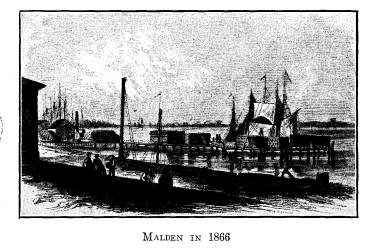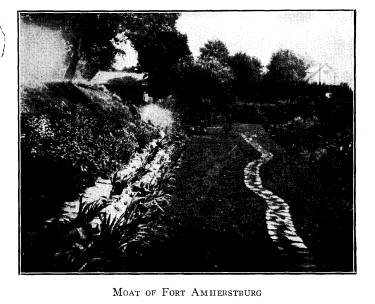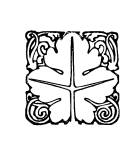Ohio History Journal
FORT MALDEN* TODAY
BY JAMES A. GREEN
In his correspondence with Washington,
William
Henry Harrison, while Governor of
Indiana Territory,
frequently reported that the Indians
had gone to Maiden
for arms and ammunition. That British
Fort at the
mouth of the Detroit River was a menace
to the men of
Ohio and Indiana in the early days. It
profoundly af-
fected our relations with the Indians.
If they disliked
our policy they could go to Malden
where the British
received them with open arms. There it was
the English
fur traders gathered and with great
success diverted the
fur trade of the northern parts of Ohio
and Indiana
from the American traders. Those
Canadian fur
traders were splendidly organized, were
fine men of
business and they were backed by the
power of their
Government. Of course, the fur trade
was a mere inci-
dental. The great thing was that Maiden
occupied a
strategic position, commanding the head
of Lake Erie
and the entrance to the Detroit River.
We had it is
true, a fort at Detroit, but Malden was
master of the
approach to it. From a military point
of view, Detroit
was badly placed. Had we built Fort
Meigs, or a fort
on the site where in 1813 General
Harrison built Fort
Meigs, we would have had an ideal location
both from a
commercial and a military standpoint.
General Hull realized the disadvantage
of Maiden at
* See editorial note at the conclusion
of this contribution.
(683)
|
684 Ohio Arch. and Hist. Society Publications the very beginning of the War of 1812 for the vessel carrying his personal baggage and his official corre- spondence was intercepted and captured by a ship sent out from there. As long as Malden stood strong and de- fended it was a menace to Detroit. General Hull started out to take it. But he lacked the courage to make a bold attack. However, I have no intention to tell the story of Fort Malden. All I have in mind is to describe |
|
|
|
it as it is at present. What was Fort Malden is now the large and flourishing city of Amherstburg, adjoining on the south the city of Windsor. Amherstburg has completely embraced and all but obliterated the old Fort. There is no monument to mark it. As the visitor drives down the main street of Amherstburg he will see on a corner an up-to-date filling station with the sign "Fort Malden Filling Station." If he turns there and goes down to the river, he comes to Fort Malden drive, a pleasant suburban avenue adorned with handsome |
Fort Malden 685
houses. There he
finds a school, a large children's play-
ground and a public
park. That is the old parade ground
of the Fort. It has
always remained public property.
As for the Fort
itself, it has been partly built upon,
though its size can
still be traced by the mounds which
were its ramparts
and the ditches which were its moat.
Peace here has
wrought so perfect a work that one en-
terprising and
artistic householder with a long extent of
the moat for a side
yard, has turned it into a sunken
garden, bright on
the August day I visited it, with a
myriad of gay
flowers. The only sign of war was a
pile of cannon balls
on the lawn. These were rusty six-
inch solid balls
which were dug up nearby. Of course,
in Amherstburg there
must be many people perfectly
acquainted with
local history, yet when I asked an in-
telligent looking
man if he could point out on the shore
the place where
General Harrison landed his army, he
replied that the
General had landed at Windsor up the
river and marched
down the road. That was the road
by which Proctor
retreated and on which the American
followed him. While
there is no bronze tablet set in a
granite boulder,
after the style which the good women of
the D. A. R. have
made so popular, to mark the exact
spot on the shore of
Lake Erie where General Harrison
landed--naturally
the Canadians would resent such a
memorial--yet it is
not difficult to identify it, that is,
within approximate
limits. The Canadian Girl Scouts
now have a summer
camp there. They were provided
with regulation
military tents and their encampment had
quite a soldierly
air. If those girls had been there when
General Harrison and
his men arrived I think the Amer-
icans would have
blushed. Not that I blushed, for girls
|
686 Ohio Arch. and Hist. Society Publications in shorts and in one-piece bathing suits are familiar enough in these days, but such a sight in 1813 I fear would have been regarded as shocking. However, if the girls had been there on that interesting historic occasion, I am sure they would have suffered no harm for General Harrison and the Western men whom he led were all of them the soul of gallantry. The shore is sandy, in fact |
|
|
|
it is a fine bathing beach. The big flat boats in which the soldiers had been ferried across the lake, could come within a few feet of the land. Commodore Perry's larger vessels were obliged to lay off a quarter of a mile or perhaps a trifle less. No local tradition remains, 1813 is too far off. The only tradition that survives is that of escaping slaves. They were brought over the Lake and apparently put on shore at the exact spot where |
Fort Malden 687
General Harrison, Governor Shelby and
their troops en-
tered Canada. And the residents point
out a large farm
house which they call "the slave
house." There lived a
kindly Samaritan who gave shelter to
the refugees.
"There it was the slaves
slept"--to put it in the local
idiom. Escaping slaves must have been
many for all the
southwestern part of Ontario is filled
with their descend-
ants. But this spot of Canadian soil
forever mem-
orable in our annals, has fallen to base
uses. In the
winter the lake is frozen over and
automobiles loaded
with liquor run from there straight
across the ice to the
United States. Worse than that, one of
the residents
told me that last winter there was a
landing field on the
ice directly in front of the Girl
Scouts Camp, where
every day airplanes were filled up with
whisky and from
there they flew "over to
Ohio." That is something of
a Roland for our Oliver. Where we once
invaded Can-
ada, now these bootlegging Canadians
return the com-
pliment by an invasion on their own
account. But it may
be that all of these rum runners are
not Canadians, for
when I asked a resident if he knew
where the Americans
landed he replied, "Oh, yes; they
landed every day last
winter on the ice right there in sight
of my front door."
Some day perhaps some local enthusiasts
will put up a
monument on the beach reciting that
here General Har-
rison landed; here the runaway slaves
found freedom;
here the Girl Scouts enjoyed life in
the open; here the
bootlegger flourished unmolested and
unafraid and here
came curious Americans who stood on the
shore and
pondered--stood on the shore and far
off across the
years heard the rolling echoes of
Commodore Perry's
guns, heard the jubilant shouts of the
Western men un-
|
688 Ohio Arch. and Hist. Society Publications der Harrison as they leaped into the water and dragged their boats ashore. Unhappy times far off--Malden now a flower garden and a park! NOTE: The name of the fort was not Fort Maiden but Fort Am- herstburg. It is almost invariably so named. Major John Richardson, a British officer who served in the War of 1812, so named it many times. Only in a few instances have writers called it Fort Maiden. The name of the town was Malden.--[Ed.] |
|
|


